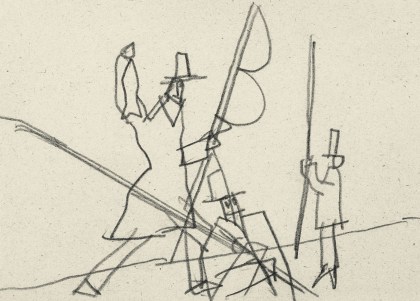
(Anglers), 1918
Pencil on paper
2 13/16 x 3 7/8 in. (7 x 10 cm)
Our current exhibition, The Enchanted World of Lyonel Feininger, on view until January 31, 2020, includes a selection of intimate works created by Lyonel Feininger at various moments in his career that reveal his warmth and sense of humor. The exhibition will be accompanied by a 160 page, fully-illustrated catalogue with essays about these works by Sebastian Ehlert and Achim Moeller. The gallery will be open on Saturdays from 11 a.m. to 5 p.m. for the duration of the exhibition. We will be closed for Thanksgiving on Thursday, November 28 and will reopen on Monday, November 30 with our regular hours, 10 a.m. to 6 p.m.
In 1918, Feininger began to make pencil drawings of ships, seascapes and small figures with top hats, perhaps inspired by motifs he saw in Braunlage, a picturesque town in the Harz mountains. The artist translated many of these drawings into woodcuts. Fifty of these mostly unpublished, spontaneous drawings for woodcuts are exhibited at Moeller Fine Art alongside a collection of 68 hand-carved and painted wooden houses and figures and 15 "Ghosties," small watercolors that Feininger gave his family and friends on holidays and special occasions.
Beginning in 1919, Feininger took scraps of wood and made little characters and houses for his children and friends-- a tradition he continued until his last Christmas in 1955. These works were collectively referred to as the “City at the Edge of the World” by Feininger's youngest son, T. Lux. Over the years, the artist presented these 68 hand-carved and painted wooden figures, houses, animals and a bridge to Andreas, his eldest son, and Wysse, Andreas's wife, who treasured them and kept them together as a group. This is the largest grouping of such works that exists in a single collection, and is unique because all the toys were given directly to Andreas and Wysse.
Perhaps the most intimate of all of the works in this exhibition, however, are the “Ghosties,” created in the late 1940s and early 1950s, which offer a glimpse into Lyonel Feininger’s personal world. The gift of a "Ghostie" was an expression of affection from the artist, or from "Papileo," as he was addressed by his family and friends.